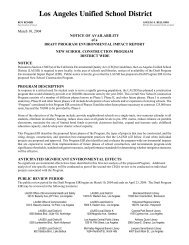Site-Specific Health and Safety Plan (HASP) - Laschools.org
Site-Specific Health and Safety Plan (HASP) - Laschools.org
Site-Specific Health and Safety Plan (HASP) - Laschools.org
Create successful ePaper yourself
Turn your PDF publications into a flip-book with our unique Google optimized e-Paper software.
3.2 CALIBRATION PROCEDURES AND FREQUENCY FOR FIELD TEST<br />
EQUIPMENT<br />
Instruments <strong>and</strong> equipment used to gather, generate, or measure environmental data will<br />
be calibrated according to manufacturer’s specifications with sufficient frequency to<br />
ensure accuracy <strong>and</strong> reproducibility of results.<br />
3.3 REVIEW OF FIELD RECORDS<br />
Field record review is an ongoing process. Field team leaders will be responsible for<br />
ensuring that proper documentation is recorded during each site's sampling activities.<br />
Field records include logbooks, log forms, <strong>and</strong> any documentation, whether electronic or<br />
hardcopy, that is used to record data, observations, assumptions, or other information in<br />
the field. The sections below describe the items used for evaluation.<br />
3.3.1 Completeness of Field Records<br />
The check of field record completeness will ensure that all requirements for field<br />
activities in the work plan have been fulfilled, complete records exist for each field<br />
activity, <strong>and</strong> the procedures specified in the work plan (or approved as field change<br />
requests) are implemented. Field documentation will ensure sample integrity <strong>and</strong> provide<br />
sufficient technical information to recreate each field event. The results of the<br />
completeness check will be documented, <strong>and</strong> environmental data affected by incomplete<br />
records will be identified in the technical report.<br />
3.3.2 Identification of Valid Samples<br />
The identification of valid samples involves interpretation <strong>and</strong> evaluation of the field<br />
records to detect problems affecting the representativeness of environmental samples.<br />
For example, field records can indicate if unanticipated environmental conditions were<br />
encountered during field activities. Records should note sample properties such as<br />
clarity, color, <strong>and</strong> odor. Photographs may show the presence or absence of obvious<br />
sources of potential contamination (during sampling). Judgments of sample validity will<br />
be documented in the technical report, <strong>and</strong> environmental data associated with poor or<br />
incorrect field work will be identified.<br />
3.3.3 Identification of Anomalous Field Test Data<br />
Anomalous field data will be identified <strong>and</strong> explained to the extent possible. Anomalous<br />
data will be assessed for usability <strong>and</strong> explained in the technical report.<br />
3.3.4 Accuracy <strong>and</strong> Precision of Field Data <strong>and</strong> Measurements<br />
The assessment of the quality of field measurements will be based on instrument<br />
calibration records <strong>and</strong> a review of any field corrective actions. The accuracy <strong>and</strong><br />
precision of field measurements will be discussed.<br />
3-2<br />
K:\Depts\Dept48\LAUSD\MSA WORK\QAPP\Draft Final QAPP to DTSC\QAPP for OU 1 RAP.DOC<br />
295







